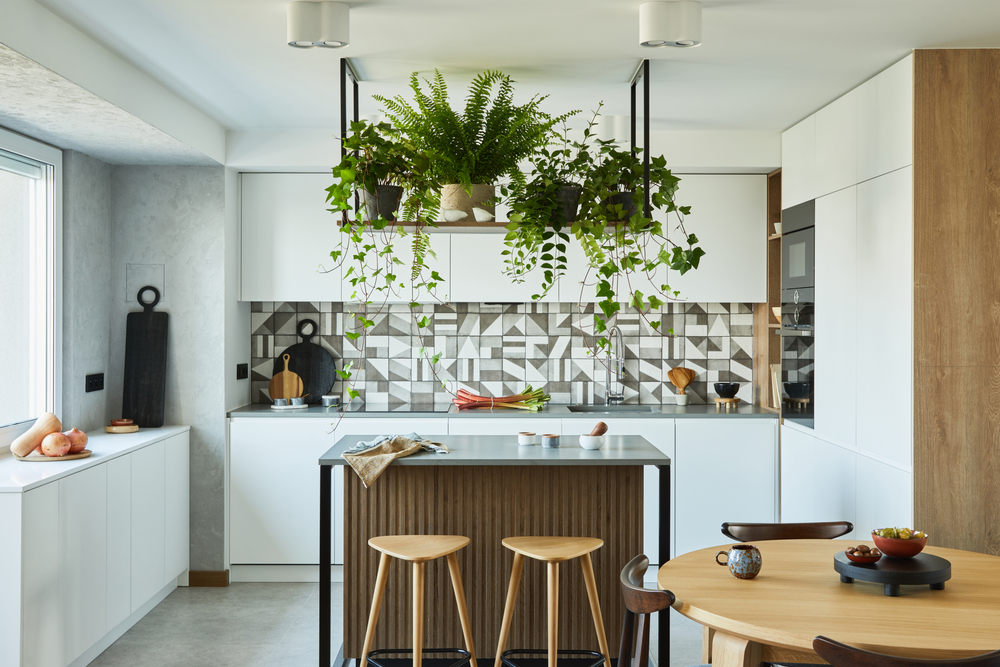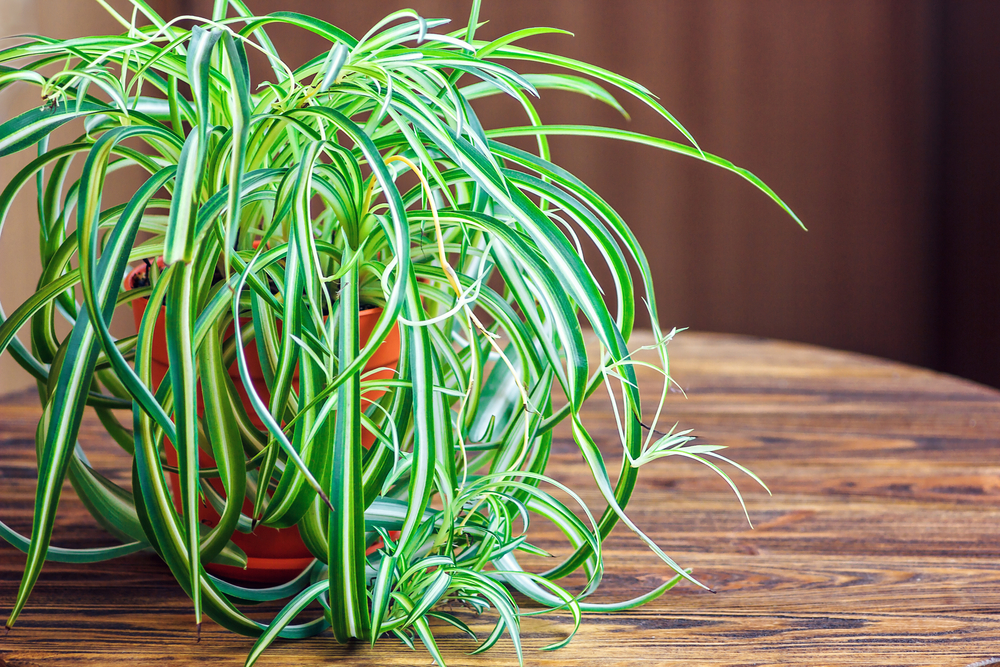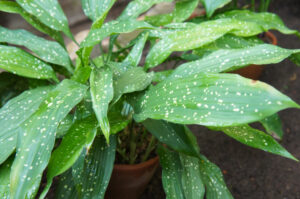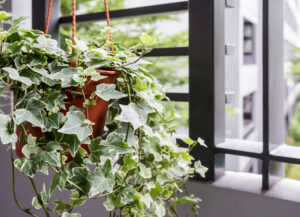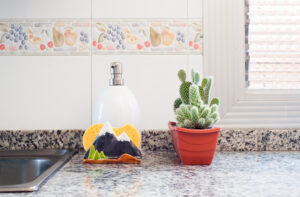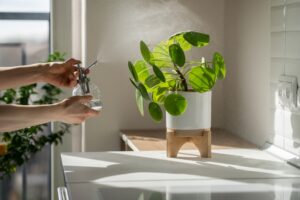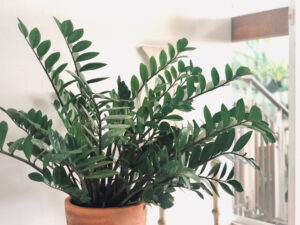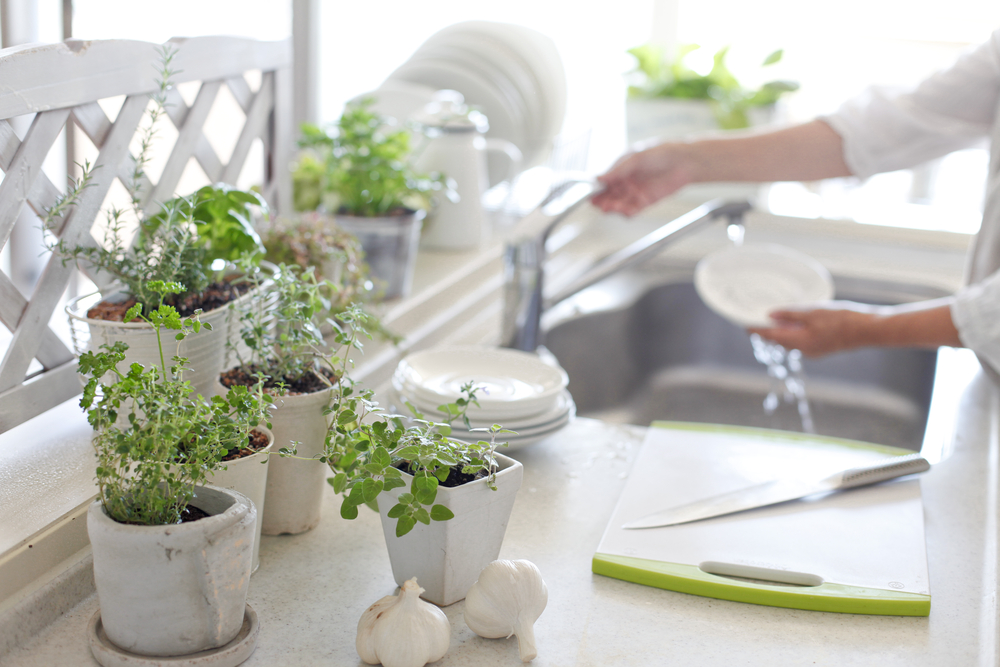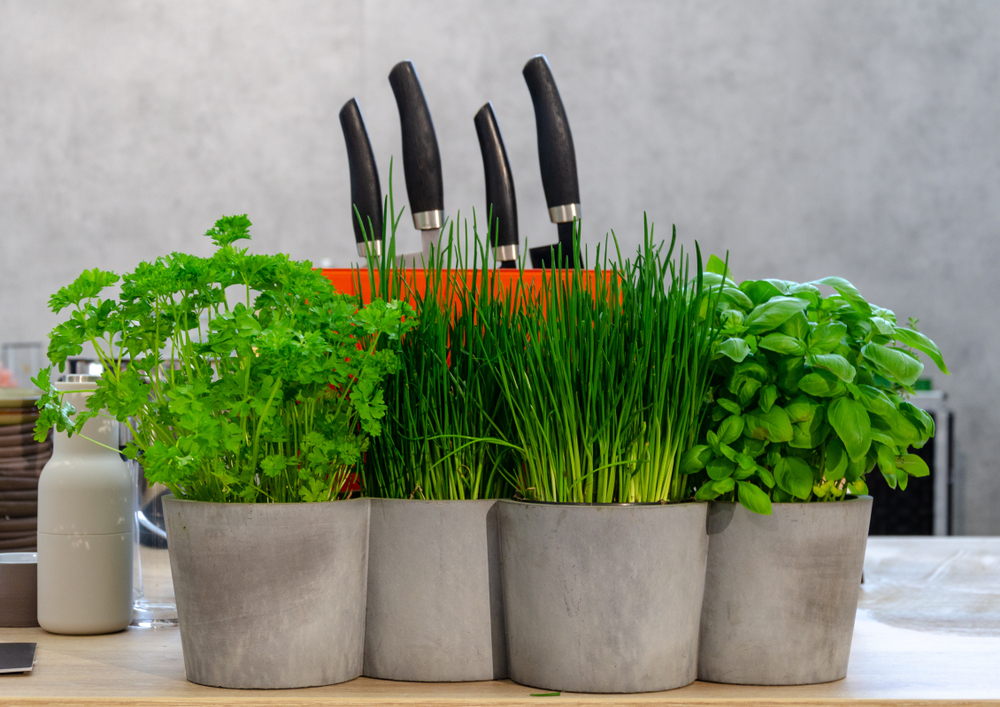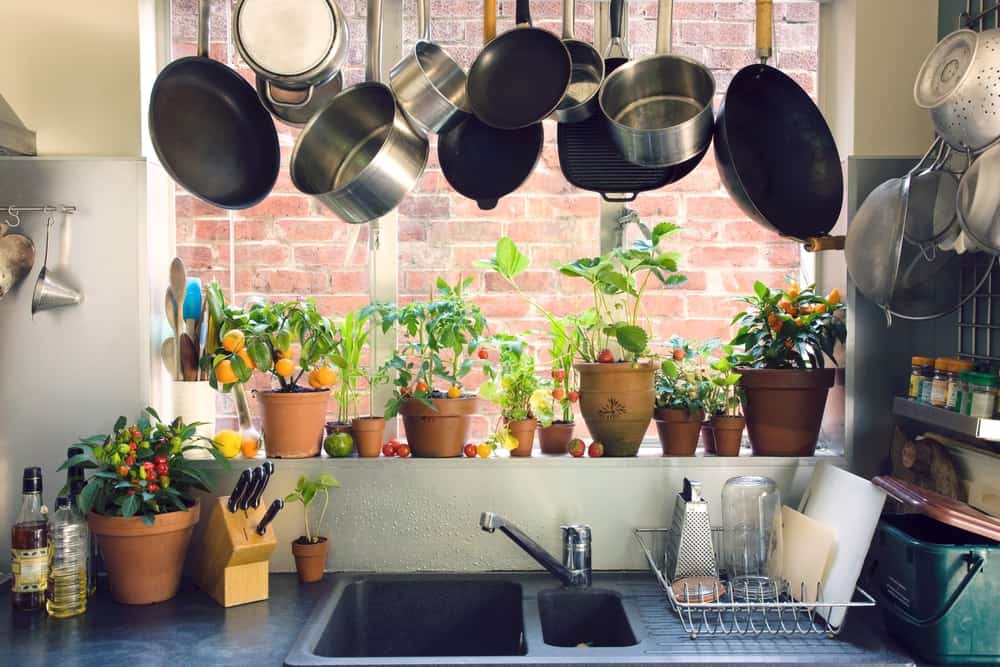HousePlantJoy is supported by our audience. When you purchase through one of our links, we may earn a small affiliate commission. As an Amazon Associate I earn from qualifying purchases. Your cost is not affected.
==================
Adding colorful kitchen plants to your cooking space is among the most rewarding. These indoor kitchen plants add color and decor to your kitchen!
The kitchen is one of the places in our homes we totally forget about when finding new homes for our houseplants. Even professional gardeners forget about using their cooking area as a feasible option to grow kitchen plants. Whether it is for decoration, first aid, or culinary purposes, an array of indoor kitchen plants thrive.
Benefits of Indoor Kitchen Plants
While these kitchen window plants will love these conditions, it will also be easier for you to care for them. Some benefits of growing houseplants in your cooking area include:
- You can easily water your plants using the sink.
- A kitchen is where you spend most of your time, so you will not forget about your leafy friends.
- Mostly, kitchens have a lot of sunlight, and that’s what your plant needs to thrive.
However, since every kitchen has its own unique humidity, light, and temperature, no one houseplant will thrive in every kitchen. So, it is important to assess these conditions and see what kitchen window plants you can grow this winter.
Tips for Decorative Indoor Kitchen Plants
- Match the color of your kitchen plant pots and flowers with your kitchen décor.
- Greenhouse indoor plants look stunning on a bright background and light yellow walls and cabinets. Moreover, Black, green, and dark brown colors are excellent choices.
- Place tall indoor kitchen plants near walls. Similarly, small houseplants look great on the countertop and under overhead cabinets.
- Tall green plants are excellent for spacious cooking places and interiors.
Below, we have divided kitchen plants into two categories; edible decorative indoor kitchen plants and edible kitchen plants.
Best Indoor Kitchen Plants for Decoration
1. Spider Plant
Spider plants are one of the best indoor kitchen plants you can grow to add a tropical look to your kitchen. These plants feature a variegated with white or solid-green roseate of thin, long, arched foliage. You can use hanging baskets to grow these plants because they look best when hanging.
Moreover, they don’t need much care and can thrive under various conditions. You can also keep the plant on the countertop or near a kitchen window and watch it grow with the help of infrequent pruning and occasional watering.
What Makes It Perfect?
- Non-toxic to pets.
- Purify air.
- Increase humidity.
- Clear airborne irritants.
- Absorb ozone.
2. Cast Iron Plant
The cast-iron plant is a non-toxic, hassle-free, and easy-to-care-for kitchen plant. The plant has a hard-to-kill reputation and features dazzling foliage within its growing zone. It can survive a variety of conditions and a lot of neglect that can kill other plants.
The plant features deep green, arching, lance-shaped, glossy leaves, reaching up to 2 feet. Cast iron is fairly a slow grower kitchen window plant. Spring is the best time to grow this houseplant. Usually, it produces purple flowers near the base that looks great. You can place the plant in the corner of your kitchen, dining room, or on the breakfast nook.
What Makes It Perfect?
- Long-lasting
- Pests-free
- Ease of care
- Purify air
- Tolerant to a variety of conditions
3. English Ivy
English ivy is a beautiful and evergreen perennial. While the plant can serve as a ground cover, it can climb as well because of its aerial rootlets. The plant produces insignificant green flowers, but this indoor kitchen plant is popular for its evergreen leaves.
You can also classify it as a foliage plant. Spring is the ideal time to grow English ivy indoors. However, not that it is a fast and aggressive grower, which means you have to prune it more often. Moreover, keep an eye on your pets because the plant is toxic.
What Makes It Perfect?
- Improved air
- Low-care
- Safe for other plants
- Help remove mold
- Humidifies indoor air
4. Cactus
Growing cacti plants in your kitchen will bring a touch of the Southwest. These plants are ideal if your kitchen is hot and dry because they thrive in these conditions. Cacti are cousins of succulents, and they too like basking in the sun. If you have a small kitchen but a windowsill, cacti can be the best kitchen window plants.
Moreover, these plants can survive without water for longer periods. However, try to water once every couple of months if the soil has dried. In simple words, if you are a neglectful houseplant owner, cacti are for you.
indoor kitchen plants
What Makes It Perfect?
- Reduces stress
- Boosts productivity
- Enhances memory
5. Pilea Peperomioides
These trendy indoor kitchen plants are must-have plants. While they are also known as “pancake plants,” Pilea peperomioides are an excellent candidate for sunny, warm kitchens. They need a lot of bright, indirect light to thrive, which means they are among the best kitchen window plants.
However, they need your attention, and if you notice the leaves are curling, they aren’t getting adequate light. Make sure to move them closer to a sunny window or any brighter spot with plenty of light. Moreover, ensure to reposition your plant once a week to help its leaves
Pilea Peperomioides
grow evenly.
What Makes It Perfect?
- Low-maintenance.
- Purify air
- Easy propagation
6. ZZ Plant
ZZ plant (Zamioculcas zamiifolia) is among those indoor kitchen plants that can tolerate a lot of neglect. They are also adaptable to almost any acceptable environment, from rooms with bright to dim light, indirect to direct light, and shady places. These plants can also tolerate drought, which means you can easily place them in the corner of your kitchen and neglect them for a couple of months.
Moreover, they also don’t need much watering and can survive for months without ill effects. ZZ plants feature evergreen, lush-green feather-like leaflets, adding a jungle-like environment to your kitchen.
ZZ Plant
What Makes It Perfect?
- Low-maintenance
- Incredibly tolerant
- Purify air
- Easy propagation
- Incredibly tolerant to a variety of light conditions
- Stress reduction
- Low water consumption
- Drought resistant
Best Edible Indoor Kitchen Plants (Herbs, Greens, Vegetables)
Growing herbs and other edibles in the kitchen just makes sense. They create a beautiful visual effect while also supplying you with fresh flavors to add to your food. Herbs grow quite easily and quickly, ensuring you always have what you need when you need it. We’ve provided a few of our favorites to get you started.
1. Mint
Mint is one of the most popular herbs we regularly use in cooking, baking, and even tea making. The kitchen plant has a refreshing flavor and aroma. Its leaves are usually dried and ground into a powder form. There are many varieties of mint, but they are divided into two main categories: hardy and tender.
Tender mints are easier to grow than the latter one. They have smaller leaves and flowers. On the flip, hardier types have larger leaves and flowers.
Moreover, while growing mint indoors, you will need a large pot to accommodate the plant’s root system. What makes mint an ideal kitchen window plant is its love of sunlight. A successful mint needs at least six hours of direct sunlight to thrive.
What Makes It Perfect?
- Rich in nutrients.
- Help relieve indigestion.
- Mask bad breath.
- Easy to include in your diet.
2. Lettuce
Lettuce is one of the best edible indoor kitchen plants with straightforward cultivation. It’s easy to grow a lot of lettuce in a tiny kitchen because it takes up very little space. You can also grow it among flowers. The best time to grow it is in the mild weather of fall and spring. It is also a viable option to grow in containers.
However, note that lettuce seeds need moist soil to flourish. You can purchase a bag of lettuce seeds or can grow it from old stems to save a few bucks. It will take six to eight weeks before your lettuce is ready to make mouth-watering wraps and salads.
What Makes It Perfect?
- Easily fits in small spaces.
- Simple sprinkling
- Easy to maintain
- Handy to harvest
3. Ginger
Ginger is among herbs that you can re-grow very easily. The herb is known for its capability to stimulate circulation, improving blood flow throughout your body. This makes it great for people suffering from poor blood circulation due to high cholesterol, diabetes, or lack of exercise.
You can use the herb, either fresh or dried, to set off food dishes. You can easily grow the herb indoors year-round, making it an excellent edible kitchen window plant. Moreover, you can use ginger in both culinary arts and medicine.
What Makes It Perfect?
- Help treat digestive issues.
- Anti-inflammatory effects
- Relieve cold symptoms
- Stimulate circulation
- Cancer-fighting properties
4. Parsley
While it is one of the most popular herbs because of its medicinal properties, parsley is also a popular indoor kitchen plant that people love to grow indoors. Growing this herb as a kitchen window plant is ornamental as well as practical.
Curly parsley features lacy, frilly foliage that looks visually stunning in any setting. Similarly, flat-leaf parsley is popular for its amazing flavor. This herb thrives in a sunny, south-facing window where it can get at least eight hours of sunlight.
However, if your kitchen window cannot provide that much light, you can use grow lights or fluorescent lighting as an alternative. Moreover, turning your parsley pot every couple of days is important to prevent leaning the plant into the sun.
What Makes It Perfect?
- Promote bone health
- Rich in antioxidants, Vitamin K, and Vitamin C
- Reduce the risk of various life-threatening conditions
- Repel insects
5. Radishes
Radishes are another easy-to-grow indoor kitchen plant. They are hardy root vegetables and can be grown multiple times in a season. Radishes plants are entirely edible, belonging to the same family as collards, broccoli, cauliflower, kale, and cabbage. You can enjoy them either raw or cooked.
Growing radishes in your kitchen is an excellent way to get fresh, delicious radishes. The root vegetable doesn’t take much space or care to thrive. You just need to soak its seeds for a few days and let them sit in warm water for a few days. Then, move these seeds into a soil-filled container about an inch deep. Now, use a plastic wrap to cover it and protect it from light drafts and breezes. You will see shoots within days.
What Makes It Perfect?
- Rich in oxidants and minerals
- Help lower high blood pressure
- Reduce risks of heart diseases.
- Contain natural nutrients
- Improve blood flow
6. Chives
While chives are easy to grow from seed, they do require some patience. You can grow them as kitchen plants about six weeks before the last frost date. Keep in mind that while growing as indoor kitchen plants, put them near a sunny window so they can get at least six hours of sunlight. In case your kitchen doesn’t have enough sunlight, you can use growing lights to keep your chives thriving.
In addition to growing chives from seed, you can also grow them from divisions for quicker growth. This herb has excellent medicinal and culinary uses. For instance, you can use them in fresh salads, soups, and stuffing. Or, you can also dry them and add them to cookies, bread, or sauces. Moreover, chive butter, pesto, and chive pickle are also popular.
Furthermore, chives are also known for their medicinal properties. You can eat raw chopped chives mixed with honey for flu and colds. They can also be used as a natural insect repellent if you put them around your home. The herb repels ants, mosquitoes, flies, and wasps, making it a multi-purpose kitchen window plant.
What Makes It Perfect?
- Excellent culinary and medicinal properties.
- Insect repellant properties.
- They are perennial.
- An excellent companion plant.
7. Cilantro
Cilantro (coriander) is a parsley family member that has been used for centuries in many cuisines worldwide. This herb is easy to grow from seed both indoors and outdoors, which makes it an excellent kitchen window plant. Cilantro seeds are readily available at local garden centers.
Regardless of whether you grow it indoors or outdoors, this herb can be pretty flavorful. You can start with seeds or starter plants as an indoor kitchen plant. Moreover, for successful cilantro, it is best to use a terra cotta terrarium, allowing greater moisture and air to penetrate the roots. Additionally, ensure your terrarium or terra cotta container has sufficient drainage holes.
Furthermore, cilantro needs more nutrients for indoor growing because its limited root system cannot access the soil as much as it would outdoors. Plus, potting soil and sand provide an excellent growing environment for indoor growing, making the herb move freely.
What Makes It Perfect?
- Protect your body against illness and infections caused by tainted foods.
- Effective against Salmonella (severe food poisoning).
- Help reduce anxiety.
- Lower blood sugar.
8. Marjoram
Marjoram can be another excellent indoor kitchen plant that you can easily grow. This herb has been used for centuries to treat respiratory ailments. Marjoram is also popular for its ability to relieve stress and anxiety. Rich in volatile oils like thymol and carvacrol, the herb is an ideal kitchen window plant for its medicinal properties. These oils have antiseptic qualities and can help combat infections.
In addition, while it prefers the Mediterranean environment, Marjoram can tolerate other conditions as well. However, for indoor growing, you should choose a sunny location where temperatures are not too hot or cold. If possible, place your herb near a window with indirect sunlight streaming through it.
Moreover, you can start with seeds about four to six weeks before the last frost. After germination, transplant your herb into an individual container or use a terrarium filled with potting mix. It is important to keep the soil moist until you see shoots.
What Makes It Perfect?
- Anti-inflammatory, antioxidants, and antimicrobial properties.
- Stress and anxiety reliever.
- A rich source of Vitamin A, Vitamin K, and Folate.
Wrapping Up
Decorating your cooking space with greenery is an excellent idea. There are a variety of indoor kitchen plants and herbs that you can easily grow. While these kitchen window plants can complement the décor of any kitchen, they need very little space to make your cooking area smell good.
FAQs
Is it good to have houseplants in the kitchen?
Adding houseplants to your kitchen is an excellent way to spruce up your décor. Growing indoor kitchen plants is great for adding a splash of color, purifying air, and fresh produce all year round.
Can I keep succulents in the kitchen?
Succulents need indirect sunlight and a small amount of water, making them your best friend. They are among the best kitchen plants to grow indoors.

